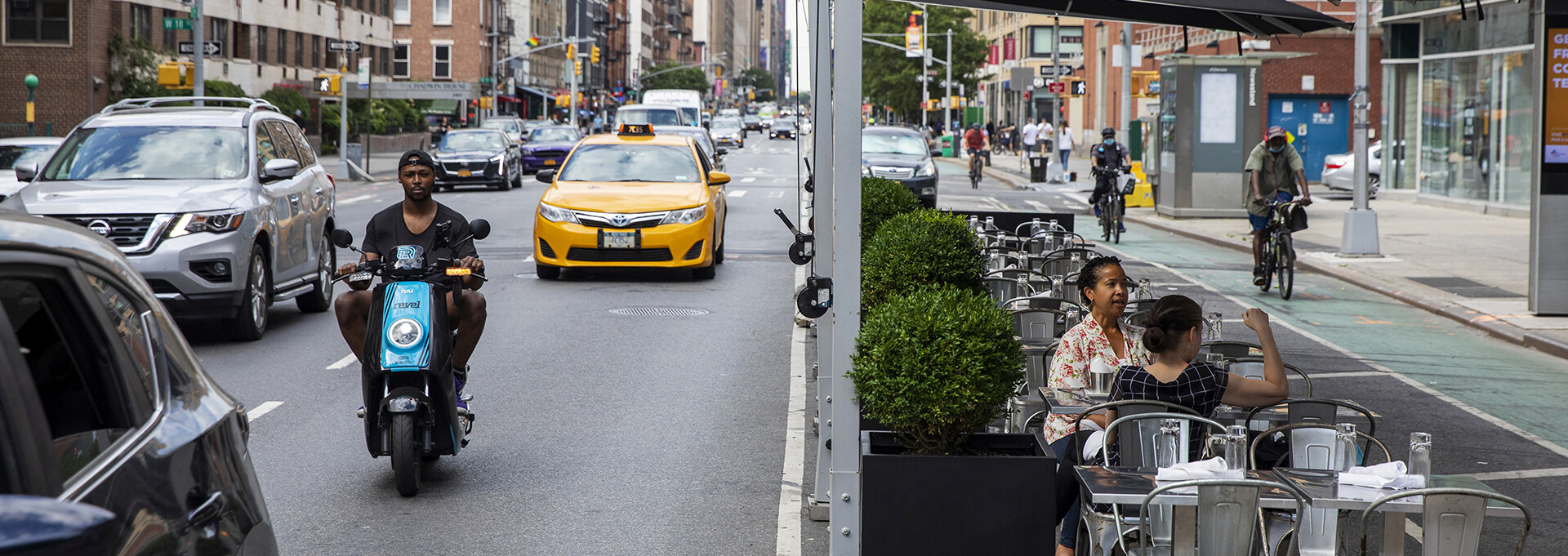Alfresco dining: why American restaurateurs can't seem to tackle the European savoir-vivre

America has been gradually reopening after the COVID-induced lockdown, and to the great delight of owners and customers, condemned to over three months of home cooking, restaurants and cafes are coming back to life. The coronavirus crisis has turned into a financial disaster as many establishments went out of business, and the survivors need all the help they can get. That is, they need their customers back. With movies, shows and gyms still off the table, going out to lunch or dinner is one of the few permitted social activities Americans can't seem to get enough of.
The ban on indoor service continues in most jurisdictions across the US, as it is thought to be riskier in terms of contagion. But since the end of June, restaurants in various part of the country have been allowed to set up dining areas outside. For lack of a cosy courtyard or an outdoor terrace, many have spilt out onto sidewalks, parking lots or have built makeshift fenced-in dining areas directly on streets. Although this solution allows for air circulation and spacing tables farther apart than indoors, it spells other kinds of trouble. At times it proves downright dangerous for patrons enjoying their meals in close vicinity to moving traffic.
An informal group called Storefront Safety Council has so far reported some 20 accidents involving cars barging into outdoor dining areas since restaurants reopened. Before US restaurants started setting up outdoor dining areas en masse, it was merely 4-5 crashes a year.
Several major accidents involving cars crashing into dining areas and injuring or even killing unsuspecting customers occurred over the past month alone.
On August 7th a police chase in Kentucky ended with two people killed when a perpetrator's car crashed into a street café. Three people sustained injuries after a Cadillac crashed into an Audi and then both vehicles ploughed into an outdoor dining area of Delizia restaurant in Upper East Side, New York, last Monday night. And the list goes on.
Why is this happening? The lack of preparation is the most obvious answer. The minute local governments sanctioned alfresco seating, restaurateurs jumped at the opportunity and created new outdoor seating capacities overnight. All of a sudden, the Big Apple started to look a whole lot like Paris, and DC like London. But not quite.
In New York nearly 10,000 restaurants have set up outdoor seating since July, using planters and railings to fence out dining areas with whatever they could lay their hands on. More cautious owners rented concrete barriers to protect customers seated on what used to be parking spaces or traffic lines. Others used potted palm trees and store-bought beach umbrellas to create a tropical vibe without giving much thought to the guests' safety. As for American drivers, they aren't used to paying attention to people enjoying their burgers and fries on the sidewalk just inches from their rear-view mirrors.
Some US municipalities made a point of ensuring people's safety rather than leaving it to the restaurants' discretion. In Los Angeles County, for example, restaurants in many neighbourhoods street dining sections are fenced off with concrete barriers or water-filled barricades.
However, in busier neighbourhoods restaurants offer their services all week long, despite heavy traffic and crowded sidewalks. San Francisco has introduced a similar programme called "Shared Spaces" that allows businesses to use parts of outdoor public spaces upon getting free, fast-tracked permits.
While alfresco dining is something that's kept many American restaurants afloat this summer, it's quite clear that it comes with many challenges. The question that inevitably comes to mind is why Americans can't seem to safely implement the practice that's been enjoyed by the Europeans since the mid-17th century. It has become an essential part of their everyday life – so much so, the city of Paris requested UNESCO put its bistro and café terraces on the world heritage list.
Well, first of all, with very few exceptions, eating outdoors has never been an American thing. Take New York, for example; its street-side gourmet experiences have always been underwhelming at best. Few restaurateurs have been willing to invest in terraces, as the clientele preferred spotless air-conditioned dining rooms to dust-laden tables on less-than-welcoming sidewalks. Plus, getting a permit allowing service outdoors has always been an ordeal - expensive, time-consuming, and subject to zoning restrictions and community board approval. Now, the New York City council streamlined the permit process and made a few accommodations for outdoor service – at least, until October 31st, when the programme is to be put on hold for the winter season.
Furthermore, Americans, who have always had a complicated relationship with alcohol (consuming in public is considered a punishable offence in the majority of cities), still feel shy about serving booze outdoors. New York State Governor Cuomo, for example, announced that alcohol is to be served only if accompanied by food. The State Liquor Authority (SLA) explained that food sales were essential to avoid "the congregating and mingling that arise in a bar service/drinking only environment" – as if it was something to frown upon. Bars that started serving to-go drinks in closed containers (read, plastic cups with a lid and a straw), are now mandated to sell their patrons at least one food item.
Still, the SLA was quick to specify that by food it meant "substantial" menu items, and that "a bag of chips, bowl of nuts, or candy alone" do not qualify. A situation, requiring to accompany every beer or Aperol spritz enjoyed outdoors with an order of food, would be unheard of in Europe, where drinking wine on a park bench isn't considered a crime either. But changing the "prohibition mentality" that lingers in America, will take more than one pandemic. Still, optimists believe the current shift will be the first step towards ushering in a new culture of outdoor eating and drinking in America.